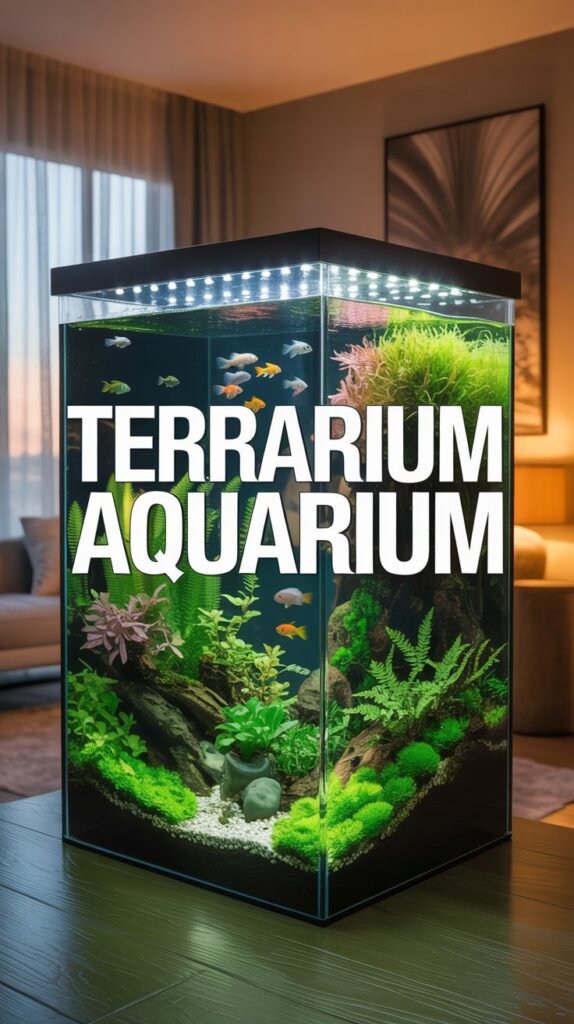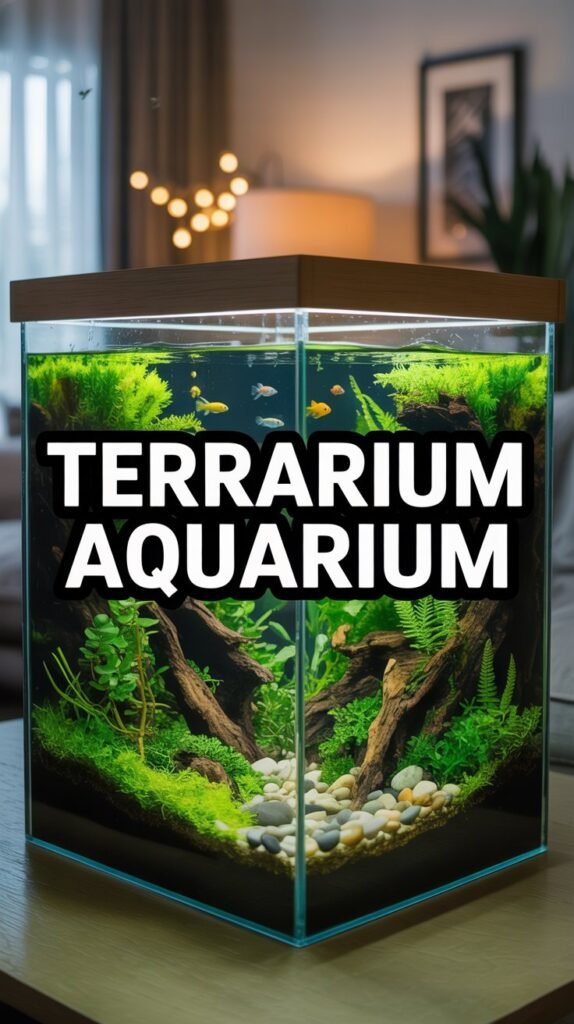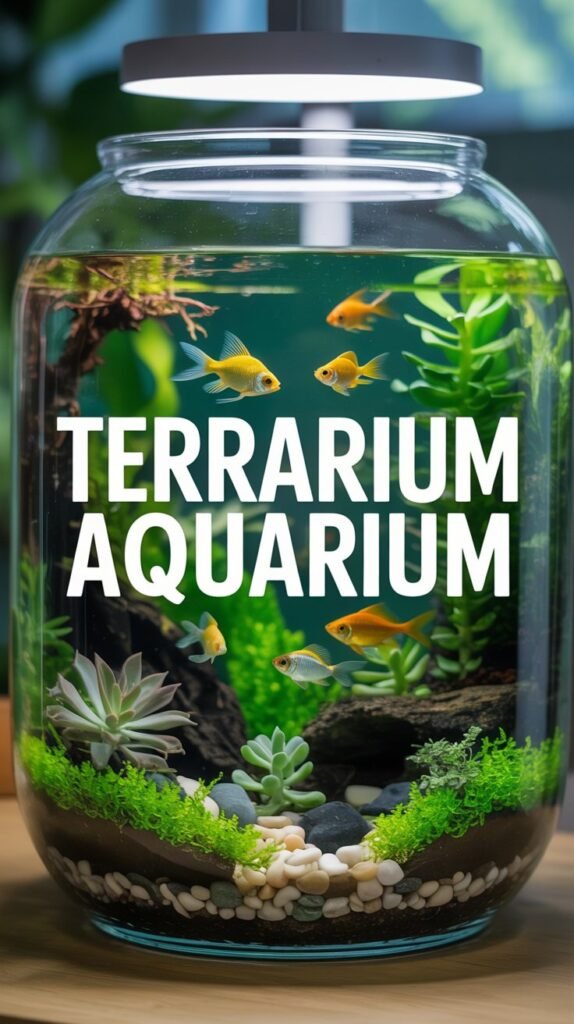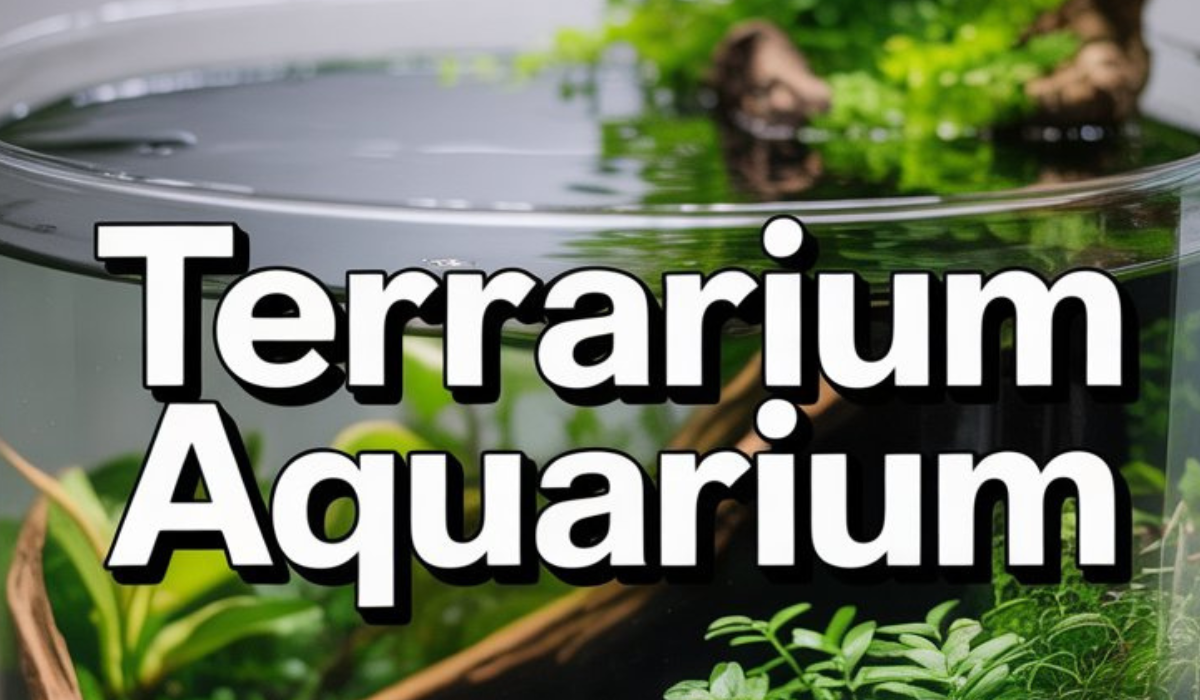A terrarium aquarium is one of the most captivating and artistic ways to bring nature into your home. Combining the best elements of both terrariums (land-based habitats) and aquariums (water-based habitats), it creates a balanced environment where plants, fish, and other small organisms can coexist beautifully. Whether you’re a beginner or a seasoned aquascaper, a terrarium aquarium offers endless possibilities for creativity, tranquility, and natural harmony.
In this comprehensive guide, we’ll explore everything you need to know about terrarium aquariums — from design ideas, setup steps, and suitable species, to maintenance and decoration tips. Let’s dive into the fascinating world where land meets water.
What Is a Terrarium Aquarium?
A terrarium aquarium, often called a paludarium, is a hybrid ecosystem that combines terrestrial (land) and aquatic (water) environments within a single enclosure. This allows you to house both aquatic and terrestrial plants, amphibians, reptiles, or small fish in one beautiful display.
Imagine a miniature rainforest or a serene riverside scene enclosed in glass — that’s the essence of a terrarium aquarium. It can range from simple planted tanks with a bit of exposed land to complex habitats that mimic tropical jungles or riverbanks.
Benefits of a Terrarium Aquarium
Creating a terrarium aquarium is more than just a hobby; it’s an immersive experience with several benefits:
- Aesthetic Appeal – These setups are visually stunning, offering a living piece of art that enhances any indoor space.
- Stress Relief – Observing plants and aquatic life has been proven to reduce stress and anxiety, promoting calmness and relaxation.
- Educational Value – Terrarium aquariums teach valuable lessons about ecosystems, balance, and the natural world.
- Low Maintenance – Once established, they require minimal care compared to traditional aquariums or houseplants.
- Customizable Design – You can tailor the layout, plant species, lighting, and decoration to suit your personal style.
Types of Terrarium Aquariums

Depending on your design preference and the species you want to include, terrarium aquariums can be categorized into a few main types:
1. Half-Water Terrarium Aquarium
This design features about 50% water and 50% land, ideal for amphibians such as frogs or newts. The balance between both zones allows for rich biodiversity.
2. Riverbank Style
In this setup, the land slopes gently into the water, mimicking a natural river edge. Aquatic plants grow near the waterline, while terrestrial plants thrive above.
3. Waterfall Terrarium Aquarium
This is a visually dynamic setup that includes a waterfall flowing from the land section into the aquatic area. It adds movement and oxygenation to the water.
4. Moss and Rock Terrarium Aquarium
Perfect for beginners, this type focuses on mosses, rocks, and ferns. It’s easy to maintain and offers a lush, green aesthetic.
5. Tropical Jungle Paludarium
This advanced setup recreates a humid rainforest environment, complete with dense vegetation, misting systems, and small creatures like frogs or shrimps.
Essential Equipment for a Terrarium Aquarium
Creating a stable and thriving terrarium aquarium requires a few essential tools and materials:
1. Tank or Enclosure
Choose a glass tank with enough height to accommodate both land and water zones. A minimum size of 20 gallons is recommended for small setups.
2. Lighting
Full-spectrum LED lights that support both aquatic and terrestrial plant growth are ideal. They simulate sunlight and enhance photosynthesis.
3. Filtration System
A small internal or canister filter keeps the water clean and oxygenated. For setups with waterfalls, the filter can double as a pump.
4. Heater (Optional)
If you’re keeping tropical species, maintain a stable temperature using a heater. Aim for 24°C–28°C (75°F–82°F).
5. Substrate
Use separate substrates for land and water:
- Aquatic section: Gravel or aquarium soil
- Terrestrial section: Coco fiber, sphagnum moss, or potting mix
6. Hardscape Materials
Rocks, driftwood, and roots add structure, visual appeal, and hiding spots for your pets.
7. Plants
Choose a mix of submerged (aquatic) and emergent (terrestrial) plants that thrive in humidity.
Step-by-Step Guide to Setting Up a Terrarium Aquarium

Follow these steps to create your own beautiful terrarium aquarium:
Step 1: Plan Your Design
Decide how much of the tank will be land and how much will be water. Sketch your layout before you start. Planning ahead helps prevent mistakes and ensures visual balance.
Step 2: Add the Base Layer
Begin with a drainage layer using pebbles or clay balls. This prevents waterlogging in the terrestrial section. Add a mesh layer above it to separate soil from the drainage.
Step 3: Build the Landform
Use rocks, foam, or driftwood to create the elevated land area. Seal gaps with aquarium-safe silicone to prevent soil from falling into the water.
Step 4: Add Substrates
Add your aquatic substrate (gravel or soil) in the water section and potting mix or moss-based substrate in the land section.
Step 5: Fill the Water
Slowly pour dechlorinated water to avoid disturbing the setup. Fill only to the level planned for the water section.
Step 6: Install Equipment
Add your filter, heater, and lighting. Position them carefully to maintain aesthetic balance.
Step 7: Planting
Plant aquatic species like Anubias, Java fern, or Cryptocoryne in the water. For the land, use humidity-tolerant plants such as Ficus pumila, Bromeliads, and Mosses.
Step 8: Introduce Fauna
Once the setup stabilizes, introduce small fish, shrimp, snails, or amphibians. Always ensure compatibility between land and aquatic species.
Step 9: Add Finishing Touches
Add decorative elements like stones, mini bridges, or small ornaments. This enhances the natural look and gives your setup a personal touch.
Best Plants for a Terrarium Aquarium
Choosing the right plants is crucial for maintaining a balanced ecosystem. Here are some top options:
Aquatic Plants
- Java Moss – Excellent for ground cover and shrimp breeding.
- Anubias Nana – Hardy, slow-growing, and thrives in low light.
- Cryptocoryne Wendtii – Great for midground planting.
- Amazon Sword – Provides a lush green backdrop.
- Hornwort – Fast-growing and helps reduce algae.
Terrestrial and Semi-Aquatic Plants
- Ficus pumila (Creeping Fig) – Excellent for vertical growth.
- Bromeliads – Bright, tropical appearance.
- Pothos (Epipremnum aureum) – Air-purifying and resilient.
- Selaginella – Soft moss-like ground cover.
- Ferns – Add lush greenery and thrive in high humidity.
Suitable Animals for a Terrarium Aquarium

Choosing animals that can coexist peacefully is vital. Here are some great options:
Aquatic Life
- Guppies
- Tetras
- Shrimps (Cherry or Amano)
- Snails (Nerite or Mystery)
Semi-Aquatic Creatures
- Frogs (Tree frogs or Dart frogs)
- Newts
- Crabs (Fiddler crabs)
- Small Turtles (for large setups)
Avoid mixing species that have different temperature or pH requirements.
Terrarium Aquarium Maintenance Tips
A terrarium aquarium is largely self-sustaining, but it still needs periodic care. Here’s how to keep it healthy:
- Regular Water Changes
Replace 10–20% of the water weekly to prevent nitrate buildup. - Prune Plants
Trim overgrown plants to maintain aesthetics and prevent overcrowding. - Clean Glass
Use a magnetic scraper to remove algae from glass surfaces. - Monitor Humidity and Temperature
Keep humidity high (70–90%) for tropical setups. Mist daily or install an automatic misting system. - Feed Sparingly
Overfeeding leads to excess waste and algae growth. Feed only what your animals consume in 2–3 minutes. - Check Filtration
Clean the filter regularly to maintain proper water flow and quality.
Decorating Ideas for a Terrarium Aquarium
Your creativity can turn a simple setup into a masterpiece. Here are a few decoration ideas:
- Mini Waterfall or Stream: Adds movement and sound.
- Rock Caves and Driftwood: Provide natural hiding spots.
- LED Background Lighting: Enhances the ambiance.
- Miniature Bridges or Statues: Adds artistic flair.
- Natural Pebbles and Mosses: Create a forest-floor effect.
Common Problems and Solutions
1. Algae Growth
Cause: Excess light or nutrients
Solution: Reduce lighting hours and avoid overfeeding. Introduce algae eaters like snails or shrimp.
2. Cloudy Water
Cause: Bacterial bloom or unwashed substrate
Solution: Perform partial water changes and clean the filter.
3. Plant Rot
Cause: Poor lighting or waterlogging
Solution: Adjust lighting intensity and ensure good drainage.
4. Mold in Land Section
Cause: Excess moisture
Solution: Increase ventilation or reduce misting frequency.
Design Themes for Inspiration
- Rainforest Theme – Dense foliage, mist effects, and small frogs.
- Zen Garden Theme – Minimalist with rocks, moss, and calm water.
- Riverbank Theme – Sloping terrain with driftwood and ferns.
- Mountain Stream Theme – Waterfall flowing through rocky terrain.
- Fantasy Theme – Add miniature houses, bridges, and glowing lights for a magical vibe.
Advantages of a Terrarium Aquarium Over a Regular Aquarium
- Dual Habitat Experience: Combines aquatic and terrestrial life in one display.
- Eco-Balance: Plants naturally filter the air and water.
- Aesthetic Variety: Offers more visual texture and depth.
- Educational Value: Teaches about ecosystems and sustainability.
- Less Water Usage: Compared to full aquariums, they require less water.
Conclusion
A terrarium aquarium is more than just a decoration; it’s a thriving ecosystem that reflects the beauty of nature in miniature form. It brings together the serenity of water and the lush vibrancy of land, creating a harmonious and mesmerizing display.
With the right balance of design, plants, and animals, your terrarium aquarium can become a living art piece that evolves over time. Whether you want a peaceful desk companion or a grand centerpiece for your living room, this hybrid environment is an ideal choice for nature lovers and aquascaping enthusiasts alike.
FAQs About Terrarium Aquariums
1. What is the difference between a terrarium and an aquarium?
A terrarium is designed for land-based plants and animals, while an aquarium is purely aquatic. A terrarium aquarium (paludarium) combines both environments.
2. Can I keep fish in a terrarium aquarium?
Yes, you can keep small fish like guppies, tetras, or shrimps in the water section of your terrarium aquarium.
3. How often should I clean my terrarium aquarium?
Perform partial water changes weekly and deep cleaning every 2–3 months. Regular pruning and glass cleaning help maintain the ecosystem.
4. Do I need a filter in my terrarium aquarium?
Yes, a filter keeps the water clean and oxygenated, ensuring the health of aquatic species.
5. Can I use tap water?
Yes, but it should be treated with a dechlorinator before adding to the tank.
6. What lighting is best for a terrarium aquarium?
Full-spectrum LED lights that support both aquatic and terrestrial plants are ideal.
7. Can I grow mosses in a terrarium aquarium?
Absolutely! Mosses like Java moss and sphagnum moss thrive in high humidity and add a natural look.
8. What is the ideal temperature for a terrarium aquarium?
Most tropical setups do well between 24°C to 28°C (75°F to 82°F).
9. Do I need to cover the tank?
Yes, a lid helps retain humidity and prevents animals like frogs or crabs from escaping.
10. How long does it take for a terrarium aquarium to stabilize?
Usually, it takes 2–4 weeks for the ecosystem to balance and become fully functional.

